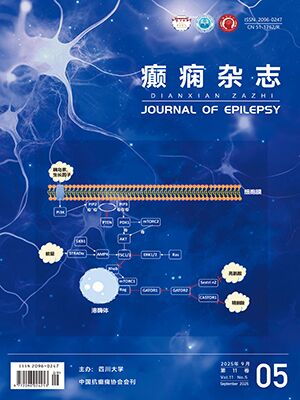| 1. |
Morgan D. Cunningham R, Zuckerman M, et al . Causes of encephalitis and differences in their clinical presentations in England: a multicentre, population-based prospective study. Lancet Infect Dis, 2011, 10: 835– 844.
|
| 2. |
Stahl JP, Mailles A, De Broucker T. Herpes simplex encephalitis and management of acyclovir in encephalitis patients in France. Epidemiol Infect, 2012, 140(2): 372-381.
|
| 3. |
McGrath N, Anderson NE, Croxson MC, et al. Herpes simplex encephalitis treated with acyclovir: diagnosis and long term outcome. J Neurol Neurosurg Psychiatry, 1997, 63: 321-326.
|
| 4. |
Lee WT, Yu TW, Chang WC, et al. Risk factors for postencephalitic epilepsy in children: a hospital-based study in Taiwan. Eur J Paediatr Neurol, 2007, 11: 302-309.
|
| 5. |
Misra UK, Kalita J. Seizures in encephalitis: predictors and outcome. Seizure, 2009, 18: 583-587.
|
| 6. |
中国抗癫痫协会. 临床诊疗指南·癫痫病分册(2023修订版). 北京: 人民卫生出版社, 2023.
|
| 7. |
Whitley RJ. Herpes simplex encephalitis: adolescents and adults. Antiviral Res, 2006, 71(2-3): 141-148.
|
| 8. |
Schiff D, Rosenblum MK. Herpes simplex encephalitis (HSE) and the immunocompromised: a clinical and autopsy study of HSE in the settings of cancer and human immunodefificiency virus-type 1 infection. Hum Pathol, 1998, 29(3): 215-222.
|
| 9. |
Tyler KL. Herpes simplex virus infections of the central nervous system: encephalitis and meningitis, including Mollaret’s. Herpes, 2004, 11(Suppl 2): 57A-64A.
|
| 10. |
Whitley RJ, Soong SJ, Hirsch MS, et al. Herpes simplex encephalitis: vidarabine therapy and diagnostic problems. N Engl J Med, 1981, 304(6): 313-318.
|
| 11. |
Sellner J, Trinka E. Seizures and epilepsy in herpes simplex virus encephalitis: current concepts and future directions of pathogenesis and management. J Neurol, 2012, 259(10): 2019-2030.
|
| 12. |
Whitley RJ, Alford CA, Hirsch MS, et al. Vidarabine versus acyclovir therapy in herpes simplex encephalitis. N Engl J Med, 1996, 314: 144-149.
|
| 13. |
Whitley RJ, Soong SJ, Linneman C Jr, et al. Herpes simplex encephalitis. Clinical Assessment, JAMA, 1982, 247: 317-320.
|
| 14. |
Singh TD, Fugate JE, Hocker SE, Rabinstein AA. Postencephalitic epilepsy: clinical characteristics and predictors. Epilepsia, 2015, 56(1): 133-138.
|
| 15. |
Lee JH, Nam DH, Oh SY, et al. Nonconvulsive status epilepticus presenting as epileptic nystagmus in a patient with herpes encephalitis. J Neuroophthalmol, 2012, 32(3): 249-251.
|
| 16. |
Steiner I, Budka H, Chaudhuri A, et al. Viral meningoencephalitis: a review of diagnostic methods and guidelines for management. Eur J Neurol, 2010, 17(8): 999-e57.
|
| 17. |
Wu HM, Huang CC, Chen SH, et al. Herpes simplex virus type 1 inoculation enhances hippocampal excitability and seizure susceptibility in mice. Eur J Neurosci, 2003, 18(12): 3294-3304.
|
| 18. |
Kirkman NJ, Libbey JE, Wilcox KS, et al. Innate but not adaptive immune responses contribute to behavioral seizures following viral infection. Epilepsia, 2010, 51(2): 454-464.
|
| 19. |
Conrady CD, Drevets DA, Carr DJ. Herpes simplex type I (HSV-1) infection of the nervous system: is an immune response a good thing? J Neuroimmunol, 2010, 220: 1–9.
|
| 20. |
Lundberg P, Ramakrishna C, Brown J, et al. The immune response to herpes simplex virus type 1 infection in susceptible mice is a major cause of central nervous system pathology resulting in fatal encephalitis. J Virol, 2008, 82: 7078-7088.
|
| 21. |
Kamei S, Sekizawa T, Shiota H, et al. Evaluation of combination therapy using aciclovir and corticosteroid in adult patients with herpes simplex virus encephalitis. J Neurol Neurosurg Psychiatry, 2005, 76: 1544-1549.
|
| 22. |
Kamei S, Taira N, Ishihara M, et al. Prognostic value of cerebrospinal fluid cytokine changes in herpes simplex virus encephalitis. Cytokine, 2009, 46: 187-193.
|
| 23. |
Fabene PF, Bramanti P, Constantin G. The emerging role for chemokines in epilepsy. J Neuroimmunol, 2010, 224: 22-27.
|
| 24. |
Friedman A, Dingledine R. Molecular cascades that mediate the inflfluence of inflflammation on epilepsy. Epilepsia, 2010, 52(Suppl 3): 33-39.
|




